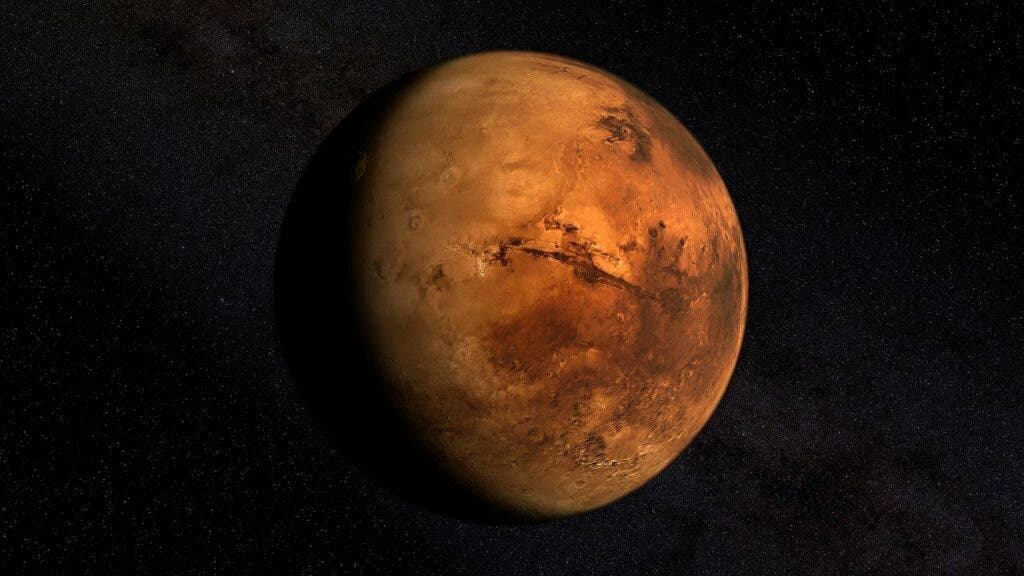New research from Caltech and JPL suggests that Mars never lost its water — it just drank it up, so to speak.

Billions of years ago, our red neighbor had an atmosphere and maintained liquid water on its surface. We know this because Mars’ surface is littered with ancient river- and lake beds. The prevailing wisdom today is that once the planet lost its geological activity and thus, its magnetic field, it lost, in turn, its atmosphere and surface water, which were blown away by solar winds.
But new research says that at least the water might still be there. According to the findings, anywhere between 30% to 99% of its original water is trapped in minerals within the Martian crust.
Better red than dry
“Atmospheric escape doesn’t fully explain the data that we have for how much water actually once existed on Mars,” says Caltech PhD candidate Eva Scheller, lead author of the paper.
According to the team, around four billion years ago Mars had enough liquid water to cover its entire surface in an ocean between 100 to 1,500 meters deep. That, they explain, would be roughly equivalent to half the entire volume of the Atlantic Ocean. However, around three billion years ago, Mars looked as it does today — dry as bone. The planet’s low gravitational pull was believed to have allowed this water to escape to space over time under the action of solar winds.
For the study, the team looked at how much water Mars has in all of its forms, as well as the chemical composition of its current atmosphere and crust. They used data beamed back by virtually every Mars rover and orbiter and that we gleaned from meteorites. A particular point of interest for them was to analyze the ratio of deuterium to hydrogen (D/H) isotopes in this water.
The vast majority of water molecules have ‘vanilla’ hydrogen in their molecules — hydrogen atoms with one proton in their nucleus. Around 0.02% of all naturally-occurring water molecules in the Universe, however, include deuterium atoms — “heavy” hydrogen, which has one proton and one neutron at its core — instead.

Regular hydrogen is also known as protium and, because of its lower atomic weight, should have an easier time escaping a planet’s gravity into space. But this also means that such a process would increase the D/H ratio in Mars’ current atmosphere (i.e. increase the presence of deuterium above the 0.02% mark), which is something we can check. What the paper argues, however, is that this escape process can’t explain where all the water that’s missing has gone, and the D/H ratio, by itself. Instead, the team proposes that another mechanism worked at the same time: the trapping of water in minerals inside the planet’s crust. Together, the team explains, they could produce the conditions we see today on Mars.
The interaction between water and silicate rocks generates minerals such as clay through a process called (chemical) weathering. These minerals often contain water in their structure. While chemical weathering takes place on both Earth and Mars all the time, Earth is tectonically active, meaning weathered minerals eventually find their way back into the mantle where they’re recycled, which brings the water back out through volcanic eruptions. Since Mars isn’t tectonically active, the water trapped in its crust is no longer being cycled back out.
“Atmospheric escape clearly had a role in water loss, but findings from the last decade of Mars missions have pointed to the fact that there was this huge reservoir of ancient hydrated minerals whose formation certainly decreased water availability over time,” says Ehlmann.
“All of this water was sequestered fairly early on, and then never cycled back out,” adds Scheller.
The team previously used a similar approach to understand how habitability on Mars evolved over time by tracking carbon dioxide, currently the main ingredient of its atmosphere. In the future, they plan to continue examining the processes through which Mars’ water disappeared in their lab, and later expand their research to nitrogen and sulfur-rich minerals. Samples to-be-recovered by the Perseverance rover will help confirm or deny their current hypothesis.
The paper “Long-term drying of Mars by sequestration of ocean-scale volumes of water in the crust” has been published in the journal Science.






